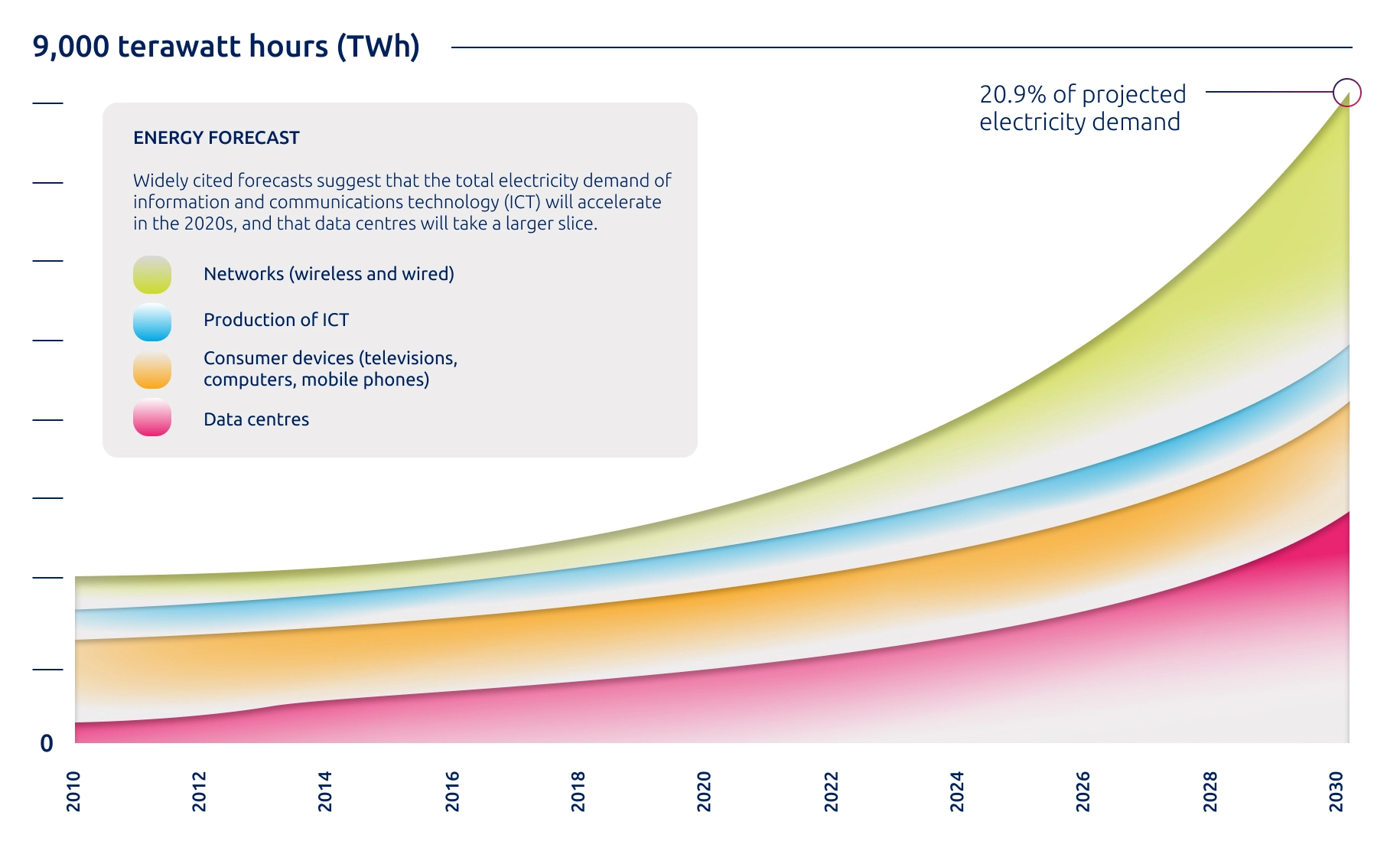Published: Oct 31, 2025
Ask the right questions on Green AI
Artificial intelligence is reshaping industries at speed and scale — but its environmental cost is rising just as quickly. The ICT sector already accounts for 4% of global CO₂ emissions, with projections climbing to 14% by 2040. Traditional AI models consume massive amounts of energy during training and deployment, driving up carbon footprints and straining infrastructure.
Green AI offers a way forward. By embedding sustainability into every stage of AI — from the chips that power models, to the way data is stored, to the intelligence that drives efficiency — organisations can accelerate innovation while reducing environmental impact. NCS sees Green AI not only as a technical imperative but as a strategic opportunity: balancing progress with responsibility and turning sustainability into a competitive advantage.
Key takeaways
- AI’s energy demands are growing exponentially and could account for 14% of global emissions by 2040[1].
- Green AI introduces three strategies — Greening Systems, Greening Data, and Greening Intelligence — to reduce energy and carbon costs.
- Organisations that adopt Green AI can drive responsible innovation without sacrificing performance.
- Policy, industry, and technology collaboration are critical to scaling sustainable AI practices.
- Green AI positions sustainability as both a business necessity and a market differentiator.
Why Green AI matters
AI adoption has surged in recent years, transforming industries from healthcare to finance, logistics to entertainment. But this rapid expansion comes with a hidden cost: energy demand. Training large-scale AI models such as GPT-3 consumed over 1,200 megawatt hours of electricity, producing the equivalent of 552 tons of carbon dioxide — the same as 123 cars on the road for a year[2].
The Green Algorithms calculator illustrates this growing challenge by estimating the carbon footprint of different AI training runs. It highlights how model size, hardware choice, and energy mix directly influence emissions, making energy-aware design decisions measurable and transparent.
With ICT already contributing 4% of global CO₂ emissions and on track to rise to 14% by 2040, unchecked growth risks undermining climate commitments. Data centres alone account for almost half this footprint, creating a cycle of energy consumption and cooling requirements that strains infrastructure worldwide.

Figure 1: The forecast of electricity demand of ICT [3].
The environmental challenge
Traditional AI models require vast data sets, compute power, and hardware lifecycles that generate e-waste. Left unchecked, these factors create rising carbon emissions, resource inefficiencies, and sustainability risks. Policymakers and enterprises alike are grappling with how to meet innovation goals while mitigating environmental impact.
The solution: Three strategies for Green AI
Green AI provides a framework to embed sustainability into AI development and deployment. Its three strategies address different pressure points:
1. Greening systems
Design and deploy hardware and software that minimise energy use and extend lifecycle value. Energy-efficient chips, sustainable materials, and AI-driven operations (AIOps) can dynamically allocate resources, reduce idle time, and cut waste.
2. Greening data
Optimise how data is stored, managed, and processed. Techniques such as compression, cold storage tiers, and efficient algorithms reduce storage costs and energy draw, while ensuring data is only active when needed.
3. Greening intelligence
Design smarter, more compact models that deliver high performance with lower energy requirements. Techniques such as pruning, quantisation, transfer learning, and knowledge distillation help reduce training cycles and computational intensity without sacrificing accuracy.

Figure 2: Key strategies of Green AI.
The outcomes: Towards responsible innovation
Adopting Green AI delivers both environmental and business outcomes:
- Reduced energy demand: From data centres using AI to optimise cooling (as seen with Google DeepMind cutting cooling costs by 40%) to renewable-powered campuses like Citadel in Reno-Tahoe.
- Lower carbon emissions: More efficient algorithms, storage, and hardware reduce the footprint of AI at scale.
- Market advantage: Hardware manufacturers such as NVIDIA, AMD, and Intel are already differentiating on energy efficiency, showing sustainability can be a competitive edge.
- Ecosystem benefits: Edge computing reduces reliance on centralised data centres, cutting transmission costs and emissions while enabling localised intelligence.
Policy and collaboration imperatives
For Green AI to scale, industry, regulators, and policymakers must work in tandem. Regulations should avoid being overly prescriptive, focusing instead on incentivising innovation and market-driven solutions. Policies must weigh both the energy consumed and the outcomes achieved to ensure AI’s benefits outweigh its costs.
Critical considerations for a sustainable Green AI future include:
- Understanding AI’s energy demand and growth trajectory
- Investing in energy-efficient algorithms, hardware, and renewable sources
- Fostering collaboration between developers, regulators, and industry leaders
- Balancing innovation with environmental stewardship to safeguard long-term progress
A balanced path for AI
Green AI represents a turning point in how organisations approach technology and sustainability. By embedding efficiency into systems, data, and intelligence, enterprises can reduce environmental impact while still accelerating innovation.
The question is no longer whether AI will transform industries, it already has, but whether we can guide this transformation responsibly. With the right strategies and collaborations, Green AI becomes both a growth driver and a safeguard for the future.
See the big picture of sustainable intelligence
Discover how the three pillars of Green AI work together to reduce emissions and power smarter innovation in our Green AI infographic.
References
[1] Simoes, G. (n.d.). Climate crisis and the technology sector. CI&T. Retrieved from https://ciandt.com/ca/en-ca/article/climate-crisis-and-technology-sector#:~:text=Current%20estimates%20show%20that%20the,emissions%20of%20the%20aviation%20sector
[2] Arab Gulf States Institute in Washington (AGSIW). (2023). The rising energy demand of AI and clouds: Unravelling the environmental conundrum. Retrieved from https://agsiw.org/analysis/the-rising-energy-demand-of-ai-and-clouds-unraveling-the-environmental-conundrum/
[3] Jones, N. (2018). How to stop data centres from gobbling up the world’s electricity. Nature, 561(7722), 163–166. https://doi.org/10.1038/d41586-018-06610-y